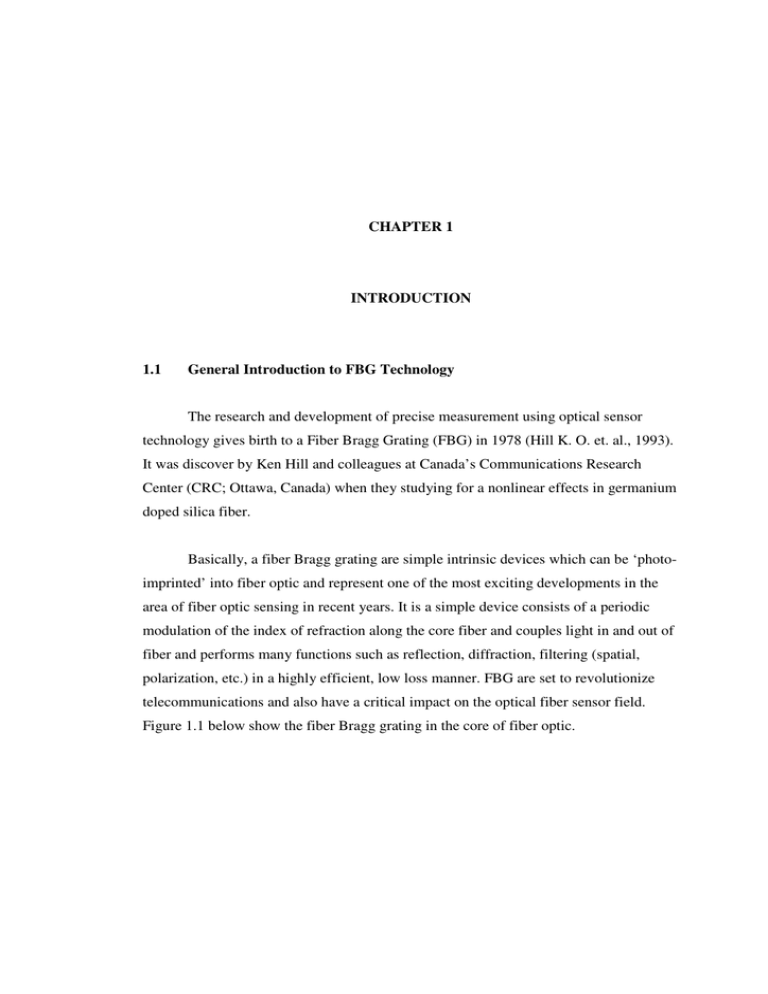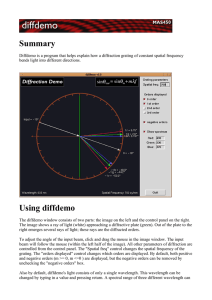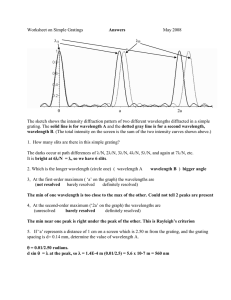CHAPTER 1 INTRODUCTION 1.1
advertisement

CHAPTER 1 INTRODUCTION 1.1 General Introduction to FBG Technology The research and development of precise measurement using optical sensor technology gives birth to a Fiber Bragg Grating (FBG) in 1978 (Hill K. O. et. al., 1993). It was discover by Ken Hill and colleagues at Canada’s Communications Research Center (CRC; Ottawa, Canada) when they studying for a nonlinear effects in germanium doped silica fiber. Basically, a fiber Bragg grating are simple intrinsic devices which can be ‘photoimprinted’ into fiber optic and represent one of the most exciting developments in the area of fiber optic sensing in recent years. It is a simple device consists of a periodic modulation of the index of refraction along the core fiber and couples light in and out of fiber and performs many functions such as reflection, diffraction, filtering (spatial, polarization, etc.) in a highly efficient, low loss manner. FBG are set to revolutionize telecommunications and also have a critical impact on the optical fiber sensor field. Figure 1.1 below show the fiber Bragg grating in the core of fiber optic. 2 Broadband Spectrum λ=λ1+λ2 Fiber Bragg Grating Reflection Spectrum, λ2=λBragg Transmission Spectrum, λ1 Λ Figure 1.1: A schematic representation of a Bragg grating inscribed in the core of an optical fiber The working principle of a fiber Bragg grating is it an optical diffraction grating with a light wave incident on the grating at an angle of θ1, can be described by the grating equation given by Hecht (2002) as n sin θ2 =n sinθ1 +m(λ/Λ) (1.1) Where θ2 the angle of the diffracted wave, n is the refractive index of the media, λ is the incident wavelength, Λ is the spatial period of the grating, and the integer m determines in the diffraction order as shown in Figure 1.2 (Van L.L. 2003). This equation predicts the direction for which constructive interference occurs and is used for determining the wavelength at which a grating most efficiently coupled light between two modes. Figure 1.2: Diffraction of a light wave by a grating 3 For a conventional fiber Bragg grating, the periodicity of the index modulation has a physical spacing that is one half of the wavelength of light propagating in the waveguide (it is phase matching between the grating planes and incident light that results in coherent back reflection) (Othonos A. and Kalli K., 1999). Reflectivity’s approaching 100% are possible, with the grating bandwidth tailored from typically 0.1 nm to in excess of tens of nanometers. These characteristics make Bragg gratings suitable for telecommunication where they are used to reflect, filter or disperse light. Fiber lasers capable of producing light at telecommunications windows utilize Bragg gratings in forming both the high-reflectivity end mirror and output coupler to the laser cavity, realizing an efficient and inherently stable source (Grattan K.T.V. and Meggitt B.T., 2000). On top of that, the advantage of using the Fiber Bragg grating (FBG) sensors have received significant interest in recent years because they have a number of distinguishing advantages compared with other implementations of fiber-optic sensors (Rao Y. J. et. al., 1995). The main advantage is the two characteristics of Bragg gratings written in Ge-doped silica fibers make them particularly attractive for sensing applications. First, the gratings are intrinsic; thus they may be inserted in small or complex structures with minimal disturbance of the structure. Second, the measurand causes a wavelength shift of the light reflected by the grating. Since the sensed signal is naturally wavelength-encoded, the sensed information is independent of source power fluctuations and losses in the connecting fibers and couplers (Weis R. S., 1994). Other advantages are: i. They give an absolute measurement insensitive to any fluctuations in the irradiance of the illuminating source, as the information is obtained by detecting the wavelength shift induced by the measurand (Morey W. W. et. al., 1991). ii. They can be written into the fiber without changing the fiber diameter, making them compatible with a wide range of situations where small diameter probes are essential, such as in advanced composite materials, human bodies etc. 4 iii. They can be mass-produced with good repeatability, making them competitive with conventional electrical sensors (Askins C. C. et. al., 1994). iv. Many gratings of FBG can be serially arranged along a fiber to create a quasidistributed sensor array. These distributed and multiplexed fiber-grating-based sensing schemes have been proposed in many ways that have been intensively investigated for use with fiber-optic sensors, such as wavelength-division multiplexing (WDM), frequency-division multiplexing (FDM), time-division multiplexing (TDM), and their combinations (Kersey A. D. et. al., 1994), making quasi-distributed sensing practically feasible. These systems are illuminated using a spectrally broad-band source and each grating reflects a narrow-band portion of the incident light spectrum. A measurand-induced change of an individual grating’s period changes the narrowband wavelength reflected by that grating. The wavelength shift of the grating-reflected light is detected at the output. (Weis R. S., 1994) 1.2 Measurement of Wavelength Shift The detection of this ‘wavelength shift’ has been the subject of considerable research and several techniques have been developed. Two techniques that using filter as their main components to detect the ‘wavelength shift’ are using bulk optic filters whose fractional power transmitted are linear functions of wavelength (over the wavelength range of interest) (Melle S. M. et. al., 1992), and the other with a fused biconical coupler (Davis M. A. et. al., 1994). Another techniques uses matched receiving-sensing grating pairs where the receiving grating tracks the wavelength shift of the sensing grating (Jackson D. A. et. al. 1993). A similar scheme uses a fiber MachZehnder interferometer and an isolated reference grating (Kersey A. D., 1993). Others use fiber laser cavities whose lasing wavelengths are dependent on the Bragg grating (Alavie A. T. et. al., 1993). Fiber Fabry-Perot (FFP) and fiber Mach-Zehnder (MZ) interferometers have also been used to detect the wavelength shifts. In the FFP scheme, the FFP acts as a tunable narrowband wavelength filter (Kersey A. D., 1993). In the MZ 5 scheme, the MZ converts the wavelength shift of the grating reflected light to a phase shift and then detects that phase shift. (Weis R. S., 1994) 1.3 Background of Problem The primary drawback of the interrogation system for FBG sensor lies in the detection of wavelength shift ∆λ of the FBG sensor return. This function can be provided by a conventional spectrometer or monochromator, or by a more simple arrangement involving a dispersive element coupled with an image array, such as a CCD detector array. The problem is the system are unapplicable due to bulk-optical nature, size, lack of ruggedness and limited resolution capability (A. D. Kersey, 1992), (Rao Y. J. et. al., 1995). In order for these gratings to be used in a practical sensor system, the determination of the peak wavelength of the narrow-band spectrum, on the order of angstroms, reflected from such a grating is of particular importance (Melle S. M. et. al., 1992). However, the cost of the optical interrogation system remains high. This points of a future where the cost of a complete system is dictated by the interrogation method rather than by the gratings themselves. The majority of Bragg gratings are interrogated in one of two ways. (Fallon R W, 1998): (a) By a tunable filter such a Fabry–Perot. These systems are moderately expensive, good for measuring static and quasi-static measurands with a resolution of about 10 µε and are particularly suitable for wavelength multiplexing. (b) By an interferometer such as an imbalanced Mach–Zender. These are expensive, complex and require a considerable amount of equipment and set-up time. Although they are ideal for measuring exceptionally small dynamic and quasi-static strain, their environmental related instability remains a difficult problem. 6 1.4 Statement of Problem A key issue with FBG sensors is it needs a high-resolution device for the detection of wavelength shift (or Bragg wavelength, λB) that had a bandwidth ~0.1 nm (Rao Y. J. et. al., 1996). In the lab, usually the Optical Spectrum Analyzer (OSA) was used to detect the wavelength shift. Although OSA has a capability of scanning to a wide range spectrum and can achieve high-resolution wavelength detection, but it is not applicable to be used with the FBG sensor on the field work. This is because the OSA is not rugged, fragile, not robust device for sensing environment, bulky in term of size and portable. Also the OSA are scanning the power in the wavelength range, so the wavelength shift is manually determine according to FBG sensor setup either the reflection or the transmission power. This is a disadvantage of time consuming to detect the wavelength range. 1.5 Scope of study The highlight of the research was the development of an interrogation unit for FBG sensor with the center wavelength of 1300nm. The work flow of this research includes: i. Design and construct setup for FBG detection unit of wavelength 1290 nm (1270 nm – 1310 nm) using optical and electronic circuit - Optical - using Motor-Driven Tunable filter and Photodetector as an optical scanner - Electronic – build interface card Serial Port from ADC/DAC ADS1212 to control Motor-Driven Tunable Filter and capture data from Photodetector using computer ii. Software development using Visual BasicI® for data acquisition and finding wavelength shift iii. Evaluate the system performance by testing with the strain FBG sensor to finds the equipment sensitivity, responsitivity, and accuracy compare to OSA. 7 1.6 Statements of hypotheses The hypotheses made are as follows; 1. the wavelength shift can be detected or defined by interrogation unit detecting using two methods: detect the peak of highest power in the transmission spectrum of fiber Bragg grating (FBG) and the peak of lowest power in reflection spectrum of FBG 2. Besides using a fiber Bragg grating (FBG) as a fiber optic sensor, theoretically it also has a capability as a high resolution interrogation unit. 3. an improvement of interrogation unit based on Fabry Perot (FP) system by using dual FBG to make Fabry Perot FBG (FPFBG) 1.7 Objectives of the study The objectives of this study are; 1. To design and construct a portable high-resolution an interrogation unit for Fiber Bragg Grating sensor, 2. To unsure the interrogation unit should be low-cost, simple system and directly give the Bragg wavelength value without needing to analyze or show the whole spectrum, 3. To determine the optimum parameter of Fabry Perot Fiber Bragg Grating in terms of length of resonator, free spectral range, minimum resolvable bandwidth, finesse and contrast factor to achieve tunable filter replacing Motor-Driven Tunable Filter for interrogation unit, 4. To test the interrogation unit to a complete sensor system. 1.8 Thesis plan This thesis comprises five chapters. In the introduction discuss the important of a FBG sensor as a state of the art technology convenience to many applications such as 8 civil monitoring, telecommunication and also surveillance. This chapter also give an inside problem to the FBG that show the important of this study to make FBG sensing system are feasible to real life application. The second chapter deals with the literature review on the previous studies done by research all over the world in the interrogation unit field. It highlights the most important system and setup cover up from 1992 until 2007 such as by using highly overcoupled couplers, mode-locked interrogation, biconical fiber filter, bandpass wavelength multiplexing, pseudoheterodyne demodulation technique, acousto-optic tunable filter and others more method describe detailly in this chapter. Also, this chapter discusson the detailed theory of FBG including the mathematical model to describe the physical meaning inside the grating and the method to simulate or design of a FBG. The focuses of this chapter also include the background theory of this whole research work on how the FBG itself can be used to develop and constructed the effective interrogation unit. Consolidation to the used of a Fabry Perot phenomenon as an added advantage to increase the performance of FBG interrogation is also distinct. The third chapter states the experimental and measurement techniques which includes research design and the apparatus used for both optical and electrically. The parameters and physical measurements are defined. The fourth chapter deals with analysis of the system performance. The characteristics of FBG as a main medium for interrogation unit are clarify both experimentally. Because of a fabrication limitation, the Fabry Perot fiber Bragg grating (FPFBG) only analyses using mathematical modelling and simulation only. In the end of this chapter, the results of a demonstration interrogation unit in practical application are presented. The final chapter summarize the findings and comments on the interrogation unit based on FBG in relation to wavelength resolution and effectiveness. Recommendations for further work are also mentioned.


